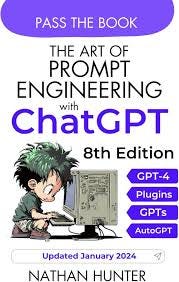How to Use ChatGPT Like a Pro
This Friday -> "The Art of Prompt Engineering with ChatGPT: Pass the Book Edition" by Nathan Hunter [3 min reading]
On Startup Salad I break down a business book’s key takeaways in a simple, digestible format, just like a good salad!
Hey, it’s Fede!
It’s pretty clear that AI is the most disruptive technology of this decade.
It’s also clear that much of what you see about AI on LinkedIn doesn’t actually exist, or at least not yet.
ChatGPT is easily the most well-known generative AI chatbot. Like everyone else, I can see a lot of potential, which is why I’m diving deeper into this topic and trying to answer these questions:
How can I get more accurate responses with ChatGPT (avoiding hallucinations)?
Can I use ChatGPT for complicated problems?
Does ChatGPT save the data? If so, how can I avoid that?
What tasks could I automate with ChatGPT to improve my workflow?
"AI will most likely lead to the end of the world, but in the meantime there will be great companies created with serious machine learning".
Sam Altman
I’ll be honest with you. In this case, I found it really hard to come across good books on the topic that weren’t too technical or too stup*d.
In the end, I decided to read "The Art of Prompt Engineering with ChatGPT: Pass the Book Edition" by Nathan Hunter, along with some other interesting online resources I found and some external support from an AI expert.
Pssss: Prompt engineering is a discipline with a lot to explore. If you’re a developer or someone deeply passionate about the topic, I highly recommend checking out this guide.
For everyone else, normal people who just want to improve their lives through AIs, I’ve put together some takeaways that anyone can easily apply to their professional lives.
Today, we’ll focus mainly on ChatGPT:
AI tools can do many things: generate text, video, and audio. However, the vast majority of problems are due to the fact that sometimes the AI does not have enough context on which it needs to operate.
Some AIs rely solely on their pre-trained models, while tools like ChatGPT combine their general knowledge, built from massive datasets, with the specific context you provide (if you do it).
For example, I find this incredibly useful for managing those repetitive client emails where they ask for the same type of non-public information. I can simply provide those details to ChatGPT, and it generates the email responses for me.
Here’s how you can provide context to ChatGPT:
Add context in your prompt: While writing your request, include key details or tell ChatGPT what to remember. It will save that info in its memory. To double-check what it’s saved, go to the top right of your profile → Settings → Personalization and settings.
Save permanent information: If you have details that never change—like your product name or company info—go to Customize ChatGPT (top-right profile icon) and add them there.
ChatGPT, as we know, is incredibly powerful, but it does have its limits. One big limitation is the length of its responses and its difficulty in solving complex problems that require multiple steps.
To solve both these problems, use the Chain Strategy.
Let’s do an example, if you want ChatGPT to create a Business Model Canvas of your startup, don’t just ask it to provide the entire canvas in one go. Instead, break it down into smaller tasks:
Start with context: Provide all the details about your startup and ask ChatGPT to remember them. Then, request the 9 components of the Business Model Canvas as a list.
Work in parts: Ask it to fill out the first 4 points (e.g., Customer Segments, Value Proposition, Channels, and Customer Relationships) based on the context you shared.
Finish with the rest: Finally, request ChatGPT to add the remaining 5 points (e.g., Revenue Streams, Key Activities, Key Resources, Key Partnerships, and Cost Structure).
By breaking complex tasks into clear, smaller steps, you’ll get more focused and accurate answers, I do this often even when I code!
Security is a big deal when it comes to data, and with AI, we need to be extra careful since there’s always the risk of sharing sensitive information.
Here’s what I did: I went to the profile icon at the top right, clicked on “Data Controls”, and under the field “Improve the model for everyone”, I switched it to OFF. This way, my data won’t be used for training purposes.
It’s a small step, but it helps keep your information safer.
So far, we’ve only seen the basic usage of ChatGPT and AI. The more advanced use, which will give a huge edge to those who master it in the future, lies in the creation of AI agents.
These are AI-based tools placed in specific work environments, trained with specialized context to perform just one task and they do it extremely well.
For example, imagine a chatbot that allows your employees to access and interact with your company’s CRM documentation. It could guide them on how to use certain functions, making training much faster and simpler.
If this sounds interesting, let me know in the poll below, and I’ll talk more about it in future editions of Startup Salad!
Now it’s time for me to take a little Christmas break. See you in the second week of January! 🎄
See you next Friday,
Federico Lorenzon









